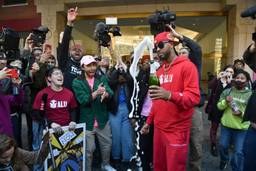Could a New NLRB Case Limit Bosses’ Best Anti-Union Tool, the Captive Audience Meeting?
Shaun Richman

The captive audience meeting, “management’s most important weapon” in an anti-union campaign, is finally being challenged in a petition to the National Labor Relations Board that could help re-balance the scales in union representation elections.
Held in all-staff, small-group or one-on-one formats, employers use these mandatory meetings to confuse and intimidate employees into voting against union representation. In a 2009 study, labor relations scholar Kate Bronfenbrenner found that nine out of ten employers use captive audience meetings to fight a union organizing drive. Threatening to cut wages and benefits in 47 percent of documented cases, and to go out of business entirely in a staggering 57 percent, these captive audience meetings correlate with an unsurprising 43 percent union win rate when used.
Such meetings were illegal under the original National Labor Relations Act. The courts eventually decided that as long as a boss’s threats were merely implicit, it would be a violation of his putative “free speech” rights for the Labor Board to restrain their ability to make his obvious opinions unavoidable. (The courts still love to use “free speech” as a justification for union-busting; Friedrichs v. CTA, the case that could decimate American public sector unions currently before the court, is a claim of infringement of free speech.)
I recently advocated for an “equal time” provision, that any mandatory on-the-clock discussion of an upcoming union certification vote make room for a pro-union presentation, be incorporated in a new labor law reform bill. But these petitioners to the NLRB — 106 of the leading labor-side and neutral-party experts on labor relations (the boss’ lawyers couldn’t bring themselves to endorse the need for fair debate, for some reason) — realized that “equal time” could be made a regulatory rule right now.
“Captive audience” meetings: not always the norm
Equal time was a rule, briefly in the 1950’s, and the NLRB is on record as inviting unions to ask for it to be restored since 1966. After the 1941 Supreme Court decision that established a boss’s First Amendment right to pummel his employees into anti-union submission, the NLRB spent the next quarter century ping-ponging back and forth between different legal standards on employer speech, union access to the employer’s property and the so-called “laboratory conditions” (basically, some fantasy world in judges’ imaginations where workers don’t feel threatened, bribed or uninformed) under which a fair election can be conducted.
In a 1966 case, General Electric Co. and McCulloch Corp., unions petitioned to overturn election losses caused by the employer’s combination of mandatory captive audience meetings and restriction of union organizers from the employer’s premises. The unions essentially sought to reestablish the equal time rules of the 1950’s. The Board declined to do so — but only conditionally and tentatively.
Their reason: on the very same day, the Board handed down a decision in a case called Excelsior Underwear, Inc., in which employers were mandated to hand over to the union a list of home addresses of all bargaining unit employees within a certain number of days of the scheduled election. The board declined to rule on the equal time complaint in General Electric “in light of the increased opportunities for employees’ access to communication which should flow from Excelsior, but with which we have, as yet, no experience.”
Several generations of union organizers now have experience with Excelsior lists. Chasing around a bunch of workers in visits to home addresses that are frequently incorrect after the boss has been free to spend an unlimited number of hours in mandatory meetings scaring the crap out of them is no substitute for having an equal amount of time at work during the workday to make the case for a “yes” vote for the union.
Why didn’t unions appeal the General Electric decision in 1967 (or 1977) after enough experience with the new Excelsior rules? The answer is probably that organizing was not an institutional and strategic priority for most international unions until John Sweeney became President of the AFL-CIO in 1995 with a promise to “organize at an unprecedented pace and scale.”
Regrettably, the organizers who recharged the union organizing departments in the mid-1990’s mostly accepted the legal rules as presented. And those of us who followed in their footsteps, myself included, mostly did the same. There is a pervasive tendency in our movement to accept that when it comes to labor structure, strategy and law, “it is what it is”— the horrible structures of American collective bargaining rules are a given and we don’t have much opportunity to change them.
Three reasons to cheer “equal time”
But this new rule, while a narrow tweak of an otherwise broken law, would be a big deal if adopted by the NLRB. First, because it would cause many employers to abandon the captive audience tactic altogether rather than make time for organizers to state the case for forming a union on the company’s premises and on the company’s time. Since these meetings are one of the boss’s principal tools for beating unions, that’s a good thing.
Other employers will likely continue the captive audience meetings and simply refuse to comply with the equal time requirement, since the only punishment for violating the rule would be a rerun election. This will particularly be the case while the new rule is inevitably challenged in the courts. In my experience, the new expedited election procedures that the NLRB instituted last May — which have increased both the number of union election petitions filed and the percentage of elections won by unions—have made employers more likely to engage in brazen violations of the Act in order to win delays before the union election. Determined to “win” at any cost, they have less fear of unfair labor practices and rerun elections, because while the legal bills will add up, at least they get to impact the election timeline.
Still, ULPs and grounds for overturning unfavorable elections, while hardly justice, are useful chips for organizers to hold. These things cost bosses money and credibility and can serve to help wear down an anti-union employer in a long-term campaign.
But the best possible outcome may come from the employers who embrace the equal time rule, thereby forcing unions to up their organizing game.
If the NLRB adopts the new rule (which is, to be clear, still a big “if”), they will almost certainly limit equal time to members of the bargaining unit only — not organizers and leaders on the union’s staff. Since intimidation is the point of captive audience meetings, some employers may assume that they can cow their own employees who stand in as union representatives.
What is needed are workers who can speak confidently and definitively on behalf of their fellow workers, in statements of “we” and “us.”
Despite the ample research that representative organizing committees are an essential component of successful campaigns, too many unions gloss over real committee building, run quick card drives and conduct too much of their contract bargaining in degrees of opacity. This is why too many organizing campaigns fail.
Take, for instance, a favorite topic of employer captive audience meetings: strikes. The boss’ message will inevitably be the union will make you go on strike. This is a double whammy of the boss’ real “most important weapon”: fear.
Fear, foremost, of the boss’ power. If the boss decides an anti-union presentation is a more important use of your time and his money than the actual job that you were hired to do and makes him money, shudder to think about what he may decide to do with your job if you defy his anti-union will.
But fear, also, of losing agency by submitting to the authority of “union bosses.” Who wants to run the gauntlet of employer opposition to workplace democracy only to find out that your union might jam decisions down your throat like the old boss did?
Imagine a well-trained and empowered workplace leader responding to the boss’s provocation with the calm explanation, “We would only go on strike if we wanted to, and had to, and if we could win. And we can only win if we all walk out together. I don’t know about you, but I would only strike for a damn good reason.” In one short breath, the boss’s message is blown away, and the workers are weighing the source of their power.
An uphill climb
The NLRB has recently issued a number of rule changes that have helped restore a degree of neutrality to workplace law. These have been extremely controversial in business circles. The Board also has issued weighty decisions regarding the ability of university graduate employees to organize and clarification on charter schools as private employers queued up for further controversy this spring. Plus, Board members who only got appointed through a rare bi-partisan deal will start seeing their terms expire this summer when an election-season Congress has little incentive to work together on approving their replacements.
All of which is to say, don’t hold your breath for a speedy response to this equal time petition.
After all, primary petitioner Charles Morris, author of The Blue Eagle At Work, has seen his petition on minority union certifications go unanswered for over a decade. His co-primary petitioner, Marquette University law professor Paul Secunda, says they understand the uphill climb. He says they filed, independently of any unions, simply to get the conversation going.
“We just want a fair vote. That’s all,” Secunda says.
If Morris and Secunda’s idea gains any traction in union circles, its fastest path to a ruling may be by a union appealing to overturn an election loss in a campaign where management locked out the organizers and conducted captive audience meetings. Unlike a petition, the NLRB would at least have to respond to such an appeal.
And there’s no shortage of grounds for appeal. Ninety percent of all union election campaigns see employers utilize captive audience meetings and more than half of those see workers directly threatened with job loss resulting in more than half of all union elections where employers subject workers to captive audience meetings. I suspect many union staffers and members reading this have a lost union election campaign near and dear to your heart that could be appealed on the grounds that Morris and Secunda lay out.
Still, Morris and Secunda’s effort highlights the value of bringing outside perspective into union strategy. While many unions are understandably focused on beating back the Friedrichs v. CTA assassination attempt and on practical efforts to sign up agency fee payers to union membership, there is a bad need for a no-holds-barred strategic dialogue on the future of labor. It would be wonderful if the AFL-CIO could formally convene it, but it clearly would need one or more of our great labor colleges to pull it together. When it comes to revitalizing the labor movement, there might not be a lot of new ideas, but there are clearly lots of good old ideas that we’ve somehow forgotten.
Shaun Richman is a labor expert at SUNY Empire State University and author of Tell The Bosses We’re Coming: A New Action Plan for Workers in the 21st Century.








